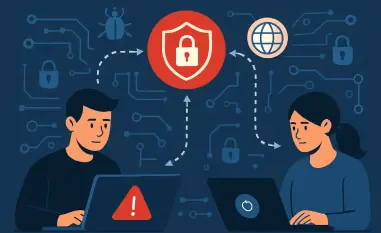Cybersecurity weaknesses are costing UK small and medium-sized enterprises (SMEs) billions annually, as highlighted in a detailed report by Ryan Daws. The findings, based on a comprehensive study conducted by Vodafone Business, reveal the staggering financial losses and the profound impact of cyber threats on these businesses. The article underscores how inadequate cybersecurity measures leave SMEs vulnerable to significant economic damages and escalating cyber incidents.
Financial Impact of Cybersecurity Failures
Substantial Economic Losses
Annually, UK SMEs suffer a collective financial loss of £3.4 billion due to inadequate cybersecurity measures. The financial burden experienced by small businesses is marked, as they lose an average of £3,398 per incident. Companies with 50 or more employees face even greater losses, with each cyber incident costing them around £5,001. This disparity in losses between small and larger SMEs underscores the vulnerability of businesses that are scaling up but have yet to fortify their cybersecurity defenses adequately. Furthermore, the accumulated annual loss indicates a systemic issue that requires urgent attention to prevent these ongoing financial hemorrhages.
These substantial losses not only affect the immediate financial health of SMEs but also have long-term implications for their operational stability and growth. For many small businesses, such unexpected expenses can disrupt cash flow, hinder investment opportunities, and even threaten their survival. With the increasing sophistication of cyber threats, the economic impact is poised to escalate unless proactive measures are implemented. The figures highlight the pressing need for these enterprises to reassess their cybersecurity strategies and invest in robust defenses.
Increasing Cyber Incidents
The frequency of cyberattacks targeting SMEs has seen a substantial rise, with 35% experiencing at least one cyber incident in the past year. Of these, 28% faced between one and five attempts, while approximately 6% encountered up to ten attempts. These statistics reflect an alarming trend that cybercriminals are increasingly focusing on SMEs, recognizing them as lucrative targets due to their often limited cybersecurity infrastructure. The rising number of attacks not only exposes the vulnerabilities within these businesses but also illustrates the relentless nature of cyber threats that continually evolve to bypass existing defenses.
The increasing incidents of cyberattacks place a continuous strain on SMEs, diverting resources away from their core business activities and towards addressing security breaches. Every attack, irrespective of its success, requires time and resources to investigate, mitigate, and recover. This constant threat environment can be particularly challenging for SMEs that lack dedicated cybersecurity teams, forcing them to manage these incidents with limited expertise and inadequate tools. The perpetual rise in cyber incidents serves as a wake-up call for SMEs to prioritize their cybersecurity posture to safeguard against potential disruptions.
Obstacles to Effective Cybersecurity
In its deliberate approach to addressing the complexities of cybersecurity, the primary challenge often lies in balancing innovation and protection. Rapid technological advancements continuously outpace existing security measures, making it difficult to maintain robust defense systems. Moreover, the lack of standardized protocols and the ever-evolving nature of cyber threats add layers of complexity to the task. Effective cybersecurity also requires collaboration among various stakeholders, including government agencies, private sector entities, and international partners. However, differing priorities and the challenge of sharing sensitive information can hinder these cooperative efforts. Additionally, the shortage of skilled cybersecurity professionals remains a significant obstacle, as there is an increasing demand for expertise in this field. Overall, addressing these obstacles requires a multifaceted approach that includes continuous improvement, cooperation, and investment in talent and technology.
Budget Constraints
One of the most significant obstacles SMEs face in implementing effective cybersecurity measures is budget constraints. Many SMEs operate with tight budgets, making it challenging to allocate sufficient resources for comprehensive cybersecurity solutions. This financial limitation often forces these businesses to opt for the most cost-effective solutions available, which may not provide the level of security needed to protect against sophisticated cyber threats. The struggle to balance cybersecurity investments with other business expenses is a persistent challenge, particularly for smaller enterprises constantly managing limited financial resources.
In addition to the cost of acquiring and maintaining cybersecurity tools, the expenses associated with training staff and keeping up-to-date with the latest security practices add to the financial burden. For many SMEs, the return on investment for cybersecurity might not be immediately apparent, leading to reluctance in committing substantial funds towards it. This underinvestment, however, can result in significant long-term costs if a successful cyber attack occurs, highlighting the false economy of skimping on cybersecurity measures.
Lack of Expertise
The absence of in-house cybersecurity expertise is another considerable barrier hindering SMEs from effectively defending against cyber threats. Many small businesses do not have the resources to hire dedicated cybersecurity professionals, resulting in a reliance on general IT staff or third-party services. This lack of specialized knowledge can lead to inadequate security measures, as general IT staff may not have the required expertise to anticipate and mitigate advanced cyber threats. The gap in cybersecurity expertise is a significant vulnerability that cybercriminals can exploit to gain unauthorized access to sensitive information.
The complexity of modern cyber threats necessitates a deep understanding of various security domains, including threat detection, incident response, and vulnerability management. Without dedicated expertise, SMEs are at a disadvantage in identifying security gaps and implementing robust safeguards. Relying on external consultants can provide some relief, but it also introduces challenges related to trust, continuity, and comprehensive understanding of the organization’s unique security needs. Bridging this expertise gap is crucial for SMEs to enhance their cybersecurity posture effectively.
Competing Priorities
Aside from financial and expertise constraints, SMEs often face competing business priorities that overshadow the need for robust cybersecurity measures. Business owners and managers must juggle various responsibilities, including growth initiatives, customer service, and daily operations. In this dynamic environment, cybersecurity can easily become a secondary concern, especially if the business has not experienced a significant cyber incident in the past. This reactive approach to cybersecurity underscores a gap in strategic planning that leaves the business susceptible to potential threats.
The inclination to prioritize immediate business objectives over long-term security can be understood given the pressures of running a small enterprise. However, overlooking cybersecurity can lead to devastating consequences if an attack occurs, potentially crippling the business and damaging its reputation. A balanced approach that integrates cybersecurity into the overarching business strategy is vital. This ensures that while day-to-day operations and growth targets are met, the critical aspect of protecting business assets and customer data is not neglected.
Employee Training and Remote Work Challenges
Training Deficiencies
A major weakness in the cybersecurity defenses of SMEs is the lack of employee training. Over half of SME employees have never received formal cybersecurity training, leaving them ill-prepared to recognize and respond to cyber threats. This lack of awareness and understanding significantly increases the risk of human error, which cybercriminals frequently exploit through phishing attacks, social engineering tactics, and other manipulative schemes. Employee training is an essential component of a robust cybersecurity strategy, as well-informed employees serve as the first line of defense against many common cyber threats.
Comprehensive training programs can equip employees with the knowledge to identify suspicious activities, follow safe online practices, and understand the importance of maintaining strong, unique passwords. Regular training sessions and updates are crucial to keeping employees aware of the latest threats and the evolving tactics used by cyber adversaries. Furthermore, creating a culture of cybersecurity within the organization, where employees are encouraged to report potential issues and follow established protocols, can significantly enhance the overall security posture of the SME.
Remote Work Risks
The rise of remote work has introduced new cybersecurity challenges for SMEs, particularly those allowing the use of personal IT equipment for work-related tasks. Remote work environments often lack the security controls present in traditional office settings, such as secure networks, firewalls, and monitored access points. The use of personal devices, which may not be adequately secured or regularly updated, increases the risk of cyber threats, providing additional entry points for cybercriminals. These vulnerabilities can lead to data breaches, unauthorized access, and the compromise of sensitive information.
To mitigate the security risks associated with remote work, SMEs need to implement robust remote work policies and invest in technologies that secure remote connections, such as virtual private networks (VPNs) and endpoint security solutions. Ensuring that remote employees have access to secure, company-approved devices and receive adequate training on safe remote work practices is essential. Regular security assessments and updates should be performed to address any emerging threats posed by the evolving remote work landscape. By addressing the unique challenges of remote work, SMEs can enhance their resilience against cyber threats while maintaining flexible work arrangements.
Common Cyber Threats Facing SMEs
Phishing Attacks
Phishing attacks continue to be the most prevalent type of cyber threat facing SMEs, with 70% of these businesses affected. These attacks typically involve deceptive emails, messages, or websites designed to trick recipients into divulging sensitive information such as passwords, credit card numbers, or other personal data. Phishing attacks exploit the human element of cybersecurity, relying on manipulation and persuasion to achieve their goals. The high success rate of phishing attacks can be attributed to their sophisticated nature, making it difficult for untrained employees to distinguish between legitimate and fraudulent communications.
The consequences of falling victim to a phishing attack can be severe, leading to data breaches, financial losses, and damage to business reputation. SMEs can protect themselves by implementing multi-layered security measures, including email filtering, two-factor authentication, and employee training programs. Raising awareness about the techniques used in phishing attacks and fostering a culture of skepticism towards unsolicited communications can significantly reduce the risk of such incidents. By equipping employees with the knowledge and tools to identify phishing attempts, SMEs can strengthen their defenses against this common cyber threat.
Ransomware
Ransomware attacks, impacting 23% of SMEs, involve cybercriminals encrypting critical business data and demanding a ransom payment for its release. These attacks can be devastating, causing significant operational disruptions and financial losses. In many cases, businesses face the difficult dilemma of paying the ransom or losing access to crucial data, each option carrying its own set of risks and implications. The rise of ransomware-as-a-service platforms has made these attacks more accessible to cybercriminals, leading to an increase in their frequency and sophistication.
To defend against ransomware attacks, SMEs need to adopt proactive security measures, such as regular data backups, the implementation of robust access controls, and the use of advanced endpoint protection solutions. Educating employees about the dangers of ransomware and training them to recognize suspicious emails or downloads can further reduce the likelihood of an attack. In the event of a ransomware incident, having a well-defined response plan that includes steps for data recovery and communication with relevant stakeholders is crucial. These preventative and responsive measures can help SMEs mitigate the impact of ransomware attacks and ensure business continuity.
DDoS Attacks
Distributed denial-of-service (DDoS) attacks, which affect around 20% of SMEs, aim to overwhelm a business’s systems and networks by flooding them with excessive traffic. This can result in significant downtime, disrupting normal operations and preventing customers from accessing services or products. The impact of a DDoS attack can be far-reaching; affecting not only the targeted business but also its customers and partners, resulting in loss of revenue and damage to business reputation. The ease of execution and relatively low cost of launching a DDoS attack make it an attractive option for cybercriminals.
To defend against DDoS attacks, SMEs need to implement a combination of network security measures, such as traffic analysis, rate limiting, and the use of content delivery networks (CDNs) that can absorb and distribute traffic loads. Engaging with a DDoS mitigation service provider can offer additional protection by monitoring and responding to threats in real-time. Regularly updating and testing DDoS response plans ensures that businesses are prepared to handle an attack efficiently, minimizing the potential impact on operations. By adopting these defensive strategies, SMEs can enhance their resilience against DDoS attacks and maintain uninterrupted service.
Water-Holing Attacks
Water-holing attacks, which involve creating fake websites or impersonating legitimate businesses to trick users into compromising sensitive information, pose a significant threat to SMEs. Cybercriminals target specific industries or groups by infecting frequently visited websites with malware, which then infects the devices of unsuspecting visitors. These attacks are particularly insidious because they exploit trusted sites and can spread malware rapidly among users who believe they are engaging with a legitimate source. The consequences of a successful water-holing attack can include data theft, unauthorized access to systems, and the spread of additional malware.
To protect against water-holing attacks, SMEs should adopt comprehensive web security measures, such as using web content filtering, implementing secure browsing practices, and conducting regular website security audits. Employee awareness and training are also critical, as users need to be vigilant about potential threats even when accessing familiar websites. Encouraging the use of strong, unique passwords and enabling two-factor authentication can further enhance security by making it more difficult for cybercriminals to exploit compromised accounts. These proactive measures can help SMEs mitigate the risks associated with water-holing attacks and protect their digital assets.
Recommendations for Enhanced Cybersecurity
Increased Funding and Support
Vodafone Business advocates for increased government funding and support initiatives to help SMEs strengthen their cybersecurity defenses. By expanding programs such as the Cyber Local Scheme, tailored cybersecurity assistance can be provided to SMEs, addressing their unique needs and challenges. These initiatives can offer financial support, access to expert resources, and continuous guidance to help businesses implement effective security measures. Increased funding can also enable SMEs to adopt advanced technologies and tools that may otherwise be out of reach due to budget constraints, ultimately enhancing their overall cybersecurity posture.
Government support can also extend to providing grants, subsidies, and incentives for SMEs to invest in cybersecurity training and infrastructure. By easing the financial burden, these initiatives can encourage more businesses to prioritize their cybersecurity needs, leading to a more secure business environment. Collaboration between government agencies, industry associations, and private sector companies can create a robust support network, facilitating the sharing of best practices and resources. Strengthening these support mechanisms is essential to helping SMEs defend against ever-evolving cyber threats.
Awareness Campaigns
Effective awareness campaigns targeted at SME owners during key business activities can play a crucial role in disseminating essential cybersecurity practices. These campaigns should highlight the importance of cybersecurity and provide practical advice on how to implement robust security measures. Raising awareness about the potential risks and consequences of cyber threats can motivate business owners to prioritize cybersecurity and take proactive steps to protect their assets. Tailored messaging that resonates with the specific needs and concerns of SMEs can result in higher engagement and more effective adoption of security practices.
Awareness campaigns can also focus on educating employees about common cyber threats, safe online behaviors, and the importance of reporting suspicious activities. By fostering a culture of cybersecurity awareness within the organization, SMEs can empower their staff to act as an additional line of defense against cyber threats. Regular updates and refreshers on emerging threats and best practices can ensure that employees remain vigilant and informed. These awareness efforts can significantly enhance the overall security posture of SMEs and reduce their vulnerability to cyber attacks.
Incentivization Measures
Incentivization measures such as simplifying access to tax reliefs through dedicated capital allowances can encourage SMEs to invest in both hardware and software for cybersecurity. By offering financial incentives, governments can lower the barriers to entry for businesses looking to enhance their security infrastructure. Tax reliefs and allowances can make it more feasible for SMEs to acquire the necessary tools and technologies needed to protect against sophisticated cyber threats. These measures create a conducive environment for businesses to prioritize cybersecurity investments without compromising other critical areas of operation.
Implementing straightforward and accessible procedures for claiming these incentives can further encourage small and medium-sized enterprises (SMEs) to take advantage of the available support. Additionally, promoting awareness of these financial benefits through industry associations and business networks can help reach a wider audience, ensuring that more businesses are informed about the opportunities to enhance their cybersecurity measures. These incentivization strategies can play a pivotal role in driving widespread adoption of robust security practices, contributing to a more secure and resilient business ecosystem.
Public-Private Partnerships
Cybersecurity vulnerabilities are causing UK small and medium-sized enterprises (SMEs) to incur billions in losses annually, as detailed in a comprehensive report by Ryan Daws. The startling findings, derived from an extensive study carried out by Vodafone Business, illuminate the immense financial toll and substantial ramifications that cyber threats impose on these businesses. The report highlights how insufficient cybersecurity protocols and measures leave SMEs highly exposed to substantial economic damages and increasing incidents of cyberattacks. These breaches can lead to the compromise of sensitive data, disrupt operations, and cause reputational damage. The article emphasizes the growing need for SMEs to bolster their cybersecurity defenses to mitigate these risks and protect their valuable assets. Investing in robust cybersecurity can prevent the devastating effects of cybercrime and safeguard SMEs against the escalating threat landscape, ensuring their ongoing viability and success in a digital world.













